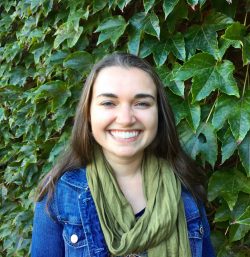Three graduate students from the College of the Environment have been awarded the National Science Foundation (NSF) Graduate Research Fellowship, which recognizes and supports outstanding graduate students in science, technology, engineering and mathematics. This year’s awardees include Irita Aylward and Zoe Krauss from the School of Oceanography, and Helena McMonagle from the School of Aquatic and Fishery Sciences.
NSF Fellows are anticipated to become knowledge experts who can contribute significantly to research, teaching and innovations in science and engineering. These individuals are crucial to maintaining and advancing the nation’s technological infrastructure and national security as well as contributing to the economic well-being of society at large.

Zoe Krauss studies earthquakes that happen beneath the ocean floor. The majority of Earth’s tectonic boundaries exist beneath the sea, and with the NSF Graduate Fellowship, she hopes to study a particularly interesting and close-to-home marine tectonic boundary: the Cascadia subduction zone.
As the Juan de Fuca plate slides beneath North America right off the coast of the Pacific Northwest, our communities are blessed with beautiful mountain ranges and dynamic topography, but also face the real risk of potentially devastating earthquakes and tsunamis. By using diverse marine seismic methods to illuminate the current mechanical state and geologic structure of Cascadia and other marine tectonic boundaries, Krauss hopes to contribute to our understanding of both fundamental earth science and seismic hazard in a tangible way.
Krauss says, “My studies as a first year PhD student in the UW School of Oceanography have already taken me to geophysical surveys as far south as Antarctica, and I can’t wait to see what the next few years have in store. I’m deeply honored to have been offered the NSF Graduate Fellowship, and am deeply grateful to the faculty and peers who reviewed and supported my application. I’m excited to get working on some great science!”

Helena McMonagle studies how humans interact with the ocean and how to sustainably use marine resources, including resources in the “twilight zone” — the layer of the ocean from 200 to 1000 meters deep where little sunlight penetrates. This vast, global habitat is home to the most abundant fish species in the world, such as lanternfish and bristlemouths, yet these extremely abundant fish are largely unexploited, despite commercial interest in harvesting them for fishmeal and nutritional supplements (e.g., fish oil).
Before large-scale harvesting begins, McMonagle and her colleagues are interested in better understanding this ecosystem and the ecosystem services that these fish provide, including their contribution to the “biological carbon pump”— an important part of the carbon cycle in which marine life increases the amount of carbon the oceans absorb (about a quarter of all carbon dioxide emitted by humans). The contribution by twilight zone fish could be substantial.
Twilight zone fish contribute to the biological carbon pump because they undertake a daily vertical migration (the largest migration in the world) to the surface to feed at night, then dive back down to the twilight zone during the day to hide from predators, where they release much of the carbon they consumed at the surface.
McMonagle plans to use funding from the Graduate Research Fellowship and pre-existing data to estimate how much carbon twilight zone fish transport, how this varies across different regions in the ocean and what drives the magnitude of that part of the biological carbon pump.
“It’s an exciting opportunity to study a living marine resource, and its value to humans, before large-scale commercial harvesting may begin. I hope my research will contribute to making informed decisions about how to use this resource in the future,” says McMonagle.

Irita Aylward’s research investigates the role of fluid flow and pore fluid pressure in geologic fault slip behavior along the Hikurangi margin offshore in New Zealand by determining fluid sources, fluid flow rates and flow pathways along the margin, specifically the relationship between fluid flow and a type of fault movement called slow slip events (SSEs). SSEs are episodes of aseismic slip that occur over a period of weeks or months. Fluid production and pore pressure accumulation are thought to be intimately linked with fault slip, but the specific mechanisms and interrelationships remain poorly understood.
Much of the populated world lies on or near a subduction zone where one tectonic plate dives beneath another creating a thrust fault often referred to as the megathrust. The rate of displacement (slip) along these plate boundary faults varies from mere centimeters per year of steady creep to meters per second during major earthquakes. Subduction zone (SZ) faults generate earthquakes and tsunamis, and understanding the mechanisms of SZ fault behavior is of critical societal importance.
Aylward says, “I am honored to receive this NSF fellowship and look forward to continuing my research on the hydrogeology of subduction zones.”

